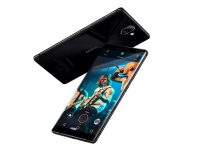Nokia has set its sight on recovering the market share it has lost in the low cost budget phone segment to the local players. Hence Nokia has upped the ante and rapidly released a number of low cost dual SIM handsets in an attempt to claw back some of it.
And Nokia 101 is another low cost dual SIM handset (must add retro looking) at the bottom of the pyramid. Let’s take a look at how the device pans out and if it’s capable of beating the local players (read manufacturers or Chinese mobiles) at their game.

In the Box:
- Nokia 101 handset
- 1020 mAh Li-Ion battery
- HS-125 earphones
- Standard pin charger
Build and Design:

The phone has a full plastic body and is very light at 69.6 grams. It has a fairly basic design with minimalistic ergonomics. On the front, it has a 1.8” TFT color screen and a rubber keypad (Nokia calls it the Island keypad) with 4 way D-pad. On the right hand side there is a slot for microSD card. It only has a speaker on the backside. It houses a 3.5 mm audio jack, torch and a pin charger slot on the top.

Overall the phone is very light and has a retro look to it. See the unboxing of the Nokia 101 unboxing and its hardware discussed in the video below:
Performance:
The device does not seem to have any reception issues. Call clarity one on the phone is good enough. Though at higher volumes the phone is prone to “voice leakage”, meaning others around you can easily hear your conversation.

The dual SIM worked perfectly in standby mode, and the other SIM gets deactivated once you are on a call so it’s not ‘dual SIM active’. We are yet to see a dual SIM active phone from Nokia which is essential if Nokia is to really compete and “WIN” in this segment.

The keypad on the Nokia 101 is of rubber and hence decent to type. Though when you start typing quickly it is where you will find problems as the keys don’t seem to respond that well and you might end up missing some letters. Interestingly the phone lags a bit while you are typing texts.
Coming to the microSD slot on the device, we were actually surprised to find one on the phone. The only reason it’s there on the phone is that it allows you to listen to music stored on the card. Though the phone is compatible with a card up to 16GB of memory, it’s difficult to imagine someone using that on the Nokia 101.

We went ahead and tested the device with a 2GB and an 8GB microSD card. The 2GB card worked smoothly and was read in no time. With a full 8GB card, the 101 was a little slow in reading it and you can imagine what it will be like with a 16GB card inside that phone. But t6he good thing is that it’s hot swappable, meaning you don’t have to switch off the device or remove the battery in order for the phone to read the memory card.
I somehow feel that a lot of customers will end up missing a USB port on the device as I do not expect many customers to carry card readers.
And if you are thinking that if the phone can save messages and contacts on the microSD card? The answer is No.
The music player has a simple interface, though I was baffled to find that it lacks basic features like forward and rewind! The speakers on the device are loud enough, though they distort and blare at higher volumes. The earphones lack bass but do the job more or less considering the price tag.
The battery on the device is very good and the phone easily lasted us a day with ample juice left even with roughly 30 minutes of calls and 2 hours of music on the speakers.
Wrap-Up:
The phone is tempting considering that it’s a dual SIM phone with a music player for a price tag of just Rs. 1699. The microSD compatibility just adds to the appeal of the device. Though, the fact that phone lags a bit and lacks some of the basic functionalities in its music player is a letdown.
Still with such features at a low price point and Nokia’s brand you can surely go for this one, if you do not mind the little flaws it carries.





